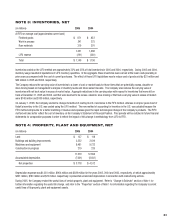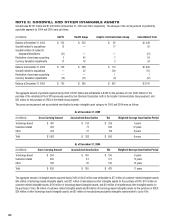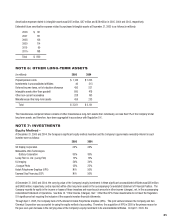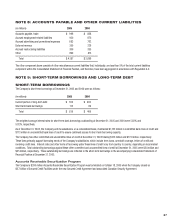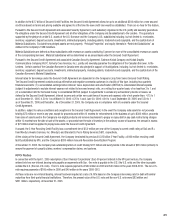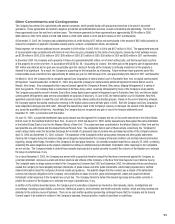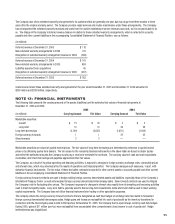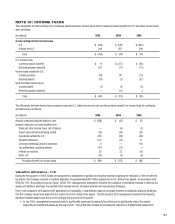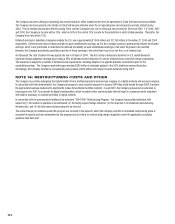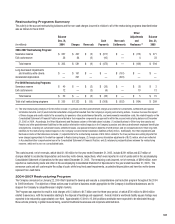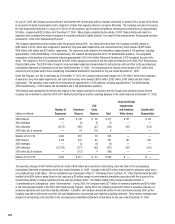Kodak 2005 Annual Report Download - page 94
Download and view the complete annual report
Please find page 94 of the 2005 Kodak annual report below. You can navigate through the pages in the report by either clicking on the pages listed below, or by using the keyword search tool below to find specific information within the annual report.92
The Company has obligations relating to other operating sites and former operations with estimated future investigation, remediation and monitoring
costs of $25 million. At December 31, 2005, these costs are accrued and included in the $171 million reported in other long-term liabilities.
The Company has completed its acquisition of KPG through the redemption of Sun Chemical Corporation’s 50 percent interest in the joint venture. The
Company also completed its acquisition of Creo. As a result of the two acquisitions, the Company has obligations with estimated future investigation,
remediation and monitoring costs of $29 million. The closure of a plant located in West Virginia was announced in the third quarter with remediation
at a cost of $24 million and is included in the $29 million. At December 31, 2005, these costs are accrued and included in the $171 million reported in
other long-term liabilities.
The Company has retained certain obligations for environmental remediation and Superfund matters related to certain sites associated with the
non-imaging health businesses sold in 1994. At December 31, 2005, estimated future remediation costs of $23 million are accrued for these sites
and are included in the $171 million reported in other long-term liabilities.
Cash expenditures for the aforementioned investigation, remediation and monitoring activities are expected to be incurred over the next thirty years
for many of the sites. For these known environmental liabilities, the accrual refl ects the Company’s best estimate of the amount it will incur under
the agreed-upon or proposed work plans. The Company’s cost estimates were determined using the ASTM Standard E 2137-01, “Standard Guide
for Estimating Monetary Costs and Liabilities for Environmental Matters,” and have not been reduced by possible recoveries from third parties. The
overall method includes the use of a probabilistic model which forecasts a range of cost estimates for the remediation required at individual sites. The
projects are closely monitored and the models are reviewed as signifi cant events occur or at least once per year. The Company’s estimate includes
equipment and operating costs for remediation and long-term monitoring of the sites. The Company does not believe it is reasonably possible that the
losses for the known exposures could exceed the current accruals by material amounts.
A Consent Decree was signed in 1994 in settlement of a civil complaint brought by the U.S. Environmental Protection Agency and the U.S. Department
of Justice. In connection with the Consent Decree, the Company is subject to a Compliance Schedule, under which the Company has improved its
waste characterization procedures, upgraded one of its incinerators, and is evaluating and upgrading its industrial sewer system. The total
expenditures required to complete this program are currently estimated to be approximately $2 million over the next four years. These expenditures
are incurred as part of plant operations and, therefore, are not included in the environmental accrual at December 31, 2005.
The Company is presently designated as a potentially responsible party (PRP) under the Comprehensive Environmental Response, Compensation and
Liability Act of 1980, as amended (the Superfund Law), or under similar state laws, for environmental assessment and cleanup costs as the result of
the Company’s alleged arrangements for disposal of hazardous substances at fi ve Superfund sites. With respect to each of these sites, the Company’s
liability is minimal. In addition, the Company has been identifi ed as a PRP in connection with the non-imaging health businesses in four active
Superfund sites. Numerous other PRPs have also been designated at these sites. Although the law imposes joint and several liability on PRPs, the
Company’s historical experience demonstrates that these costs are shared with other PRPs. Settlements and costs paid by the Company in Superfund
matters to date have not been material. Future costs are also not expected to be material to the Company’s fi nancial position, results of operations or
cash fl ows.
The Clean Air Act Amendments were enacted in 1990. Expenditures to comply with the Clean Air Act implementing regulations issued to date have
not been material and have been primarily capital in nature. In addition, future expenditures for existing regulations, which are primarily capital in
nature, are not expected to be material. Many of the regulations to be promulgated pursuant to this Act have not been issued.
Uncertainties associated with environmental remediation contingencies are pervasive and often result in wide ranges of outcomes. Estimates
developed in the early stages of remediation can vary signifi cantly. A fi nite estimate of costs does not normally become fi xed and determinable at
a specifi c time. Rather, the costs associated with environmental remediation become estimable over a continuum of events and activities that help
to frame and defi ne a liability, and the Company continually updates its cost estimates. The Company has an ongoing monitoring and identifi cation
process to assess how the activities, with respect to the known exposures, are progressing against the accrued cost estimates, as well as to identify
other potential remediation sites that are presently unknown.
Estimates of the amount and timing of future costs of environmental remediation requirements are by their nature imprecise because of the continuing
evolution of environmental laws and regulatory requirements, the availability and application of technology, the identifi cation of presently unknown
remediation sites and the allocation of costs among the potentially responsible parties. Based upon information presently available, such future costs
are not expected to have a material effect on the Company’s competitive or fi nancial position. However, such costs could be material to results of
operations in a particular future quarter or year.
Additionally, as of December 31, 2005, the Company has recorded approximately $66 million of asset retirement obligations in its Consolidated
Statement of Financial Position, primarily related to asbestos removal costs. Refer to discussion of the implementation of FASB Interpretation No. 47
in Note 1 for further information.



